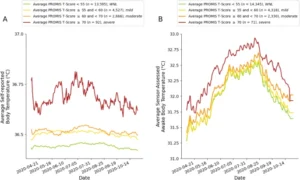A new study led by UCSF researcher Ashley Mason, PhD, in partnership with UCSF, UCSD, and other universities across the United States, used Oura alongside self-reported depression symptoms in an attempt to establish a more definitive link between depression and body temperature.
Read the full study here.
Body Temperature: A Potential Therapeutic Target for Depression
Initial studies have indicated a link between body temperature and depression – specifically, a higher-than-average body temperature (particularly at night), and smaller differences in body temperature during sleep versus during wakefulness. Increased body temperature and small differences between body temperature when awake versus asleep suggest “thermoregulatory dysregulation,” and people with depression may be more likely to experience such dysregulation.
There are many possible mechanisms that can cause this dysregulation, including changes in the autonomic nervous system and the hypothalamic pituitary adrenal axis.
Nonetheless, the connection poses an intriguing possibility for detecting depression symptoms by using temperature-tracking technology such as the Oura Ring. Oura unobtrusively tracks members’ digital biomarkers, making it an invaluable tool for this type of scientific research.
READ MORE: Can Oura Ring Help Predict Symptoms of Depression & Anxiety?
Study Design
The TemPredict Study, started in March 2020, was a prospective, worldwide, cohort study that used Oura and self-reported temperature tracking to predict the onset of a COVID-19 infection. The data collected was then used for this analysis.
Participants could report on their temperature in two different ways. They could use 1) oral thermometers, taken once per day and recorded via an online survey; and 2) the Oura Ring, measured (at most) every minute, day and night. Some people reported both, and some did one or the other, resulting in two different analytic samples.
Participants could also complete monthly surveys that asked them a range of questions relating to depression symptoms.
The data were recorded over seven months.
Sample group recording self-reported temperature:
- 20,880 participants
- Mean age was 46.9 years
- 53% male, 47% female
- Participants completed 3.6 out of 7 possible depression assessments, with a mean of 27 daily temperature reports per participant, totaling 559,665 body temperature records.
- The average depression score across the study period was 51.49.
Sample group using Oura Ring-reported temperature:
- 21,064 participants
- Mean age was 46.5 years
- 56% male, 44% female
- Participants needed to have an average of 35.5 days of temperature data prior to each depression assessment, and on average, participants completed 4 of 7 possible assessments.
- The average depression score across the study period was 50.94.
For the Oura Ring-reported temperature sample, the research team analyzed four distal body temperature metrics:
- Distal body temperature while awake
- Distal body temperature while asleep
- The difference between awake and asleep distal body temperature
- The variation in daytime distal body temperature
Linear regression models were then used to correlate depressive symptoms and body temperature.
READ MORE: Understanding the Normal Fluctuations in Body Temperature
Key Findings
The researchers discovered the following associations:
Results from the self-reported temperature sample:
- The average daily recorded body temperature correlated with the average depression score (higher daily body temperature, higher depression score) in both unadjusted and adjusted models (adjusted for age, sex, and the time that participants reported their body temperature).
- Higher body temperature was associated with increased odds of having higher depressive symptoms: In an unadjusted analysis, researchers found that for every 0.1°C increase in average body temperature, the risk of depression increased.
Results from the Oura Ring-reported temperature sample:
- Higher distal body temperature was significantly associated with more depressive symptoms during the awake period.
- Participants who reported severe depressive symptoms also tended to have lower variations in distal body temperature throughout the day, and smaller differences in distal body temperature between awake and asleep periods – compared to individuals with moderate or mild depressive symptoms.
- Changes in distal body temperature were most significant when comparing participants who reported depressive symptoms within normal limits versus those who reported severe symptoms.
- As depressive symptoms increased, there was less daily variation in temperature.

Implications of Findings
This study is the largest known study of its kind, with more than 20,000 participants from around the world. The findings of this study support the associations found in previous smaller studies showing correlations between depressive symptoms and body temperature.
However, the cause of the correlation is yet to be determined. The researchers suggest possible mechanisms, including increased metabolic heat production in depression, or a decreased ability to induce thermoregulatory cooling.
Interventions that directly target the thermoregulatory system have been found to have antidepressant benefits for people with clinical depression. For example, some studies have shown that sauna and hot baths can reduce depression symptoms. Researchers believe this may work by causing acute increases in body temperature that are followed by a rebound lowering of body temperature – perhaps a sort of “thermoregulatory workout.” These analyses make a meaningful contribution to the evidence base for associations between depression and body temperature.
Read the full study here.
RELATED: Can Researchers Use Oura To Spot Signals Associated with COVID-19?




